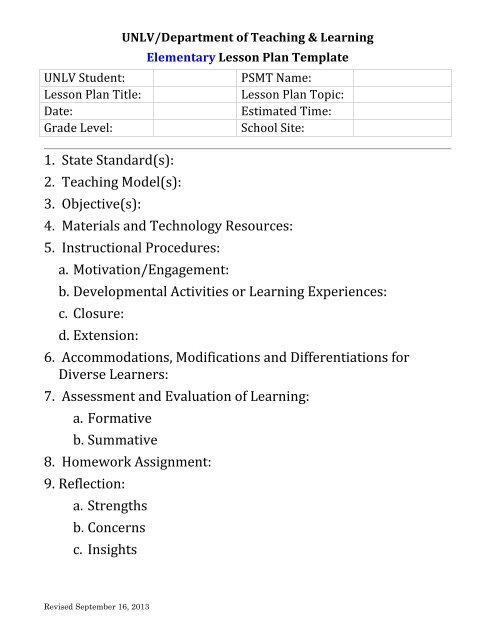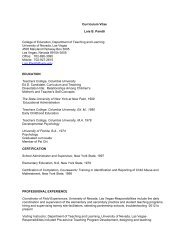Elementary Lesson Plan Template - Department of Teaching ...
Elementary Lesson Plan Template - Department of Teaching ...
Elementary Lesson Plan Template - Department of Teaching ...
- No tags were found...
You also want an ePaper? Increase the reach of your titles
YUMPU automatically turns print PDFs into web optimized ePapers that Google loves.
UNLV Student: <strong>Lesson</strong> <strong>Plan</strong> Title: Date: Grade Level: 1. State Standard(s): 2. <strong>Teaching</strong> Model(s): 3. Objective(s): UNLV/<strong>Department</strong> <strong>of</strong> <strong>Teaching</strong> & Learning <strong>Elementary</strong> <strong>Lesson</strong> <strong>Plan</strong> <strong>Template</strong> PSMT Name: <strong>Lesson</strong> <strong>Plan</strong> Topic: Estimated Time: School Site: 4. Materials and Technology Resources: 5. Instructional Procedures: a. Motivation/Engagement: b. Developmental Activities or Learning Experiences: c. Closure: d. Extension: 6. Accommodations, Modifications and Differentiations for Diverse Learners: 7. Assessment and Evaluation <strong>of</strong> Learning: a. Formative b. Summative 8. Homework Assignment: 9. Reflection: a. Strengths b. Concerns c. Insights Revised September 16, 2013
<strong>Elementary</strong> <strong>Lesson</strong> <strong>Plan</strong> Description Page # 1<strong>Elementary</strong> <strong>Lesson</strong> <strong>Plan</strong> Detailed Description 1. State Standards: Standards refer to state approved, subject and grade level specific, documents. <strong>Lesson</strong>s must address at least one standard. District level curriculum documents usually link objectives to standards, however, you may also identify appropriate standards by consulting the state department <strong>of</strong> education’s listing <strong>of</strong> approved state standards for your content area. 2. <strong>Teaching</strong> Model: For methods courses, this maybe dictated via a methods instructor’s syllabus. Simply put the name <strong>of</strong> the teaching method(s) here, eg: “Direct or Indirect Instruction” – Cooperative learning; Centers 3. Objective(s): If you are placed in a field experience, objectives should be sourced from specific district specific curriculum documents. When providing an objective, also provide any specific numbering that refers to district curriculum and state standards. Include four parts; Audience, Behavior, Degree, Condition If you are not using a district specific curriculum document: using Bloom’s (revised) taxonomy, clearly state the objective(s) <strong>of</strong> the lesson. The objectives should be SMART (student-‐centered, measureable, attainable, reasonable, and teachable). Make sure you consider higher levels <strong>of</strong> learning and ensure that you have considered and addressed cognitive, affective and psychomotor domains (as applicable). Also, align the standards from #1 above to your objectives. Which objective(s) meet which standard(s) 4. Materials & Resources: Use a variety <strong>of</strong> modes and materials (e.g., use <strong>of</strong> internet, textbooks, handouts, overhead transparencies, PowerPoint, videos, guest speakers). Include description <strong>of</strong> quantity, distribution and collection strategies. 5. Instructional Procedures: General Guidelines This section includes the a. Motivation/Engagement, b. Activities or Student Learning Experiences, c. Closure, and d. Extension and Contingency <strong>Plan</strong>s. • Indicate an estimated time for each step in the instructional procedures. • Steps: Is the new material presented in small steps, focusing on one skill or concept at a time? Are there sufficient and appropriate examples? Are examples concrete? • Management issues: Where and how will the transitions in the lesson occur? How will you begin? What is your quiet signal? • Technology use: What technological aids are you use to help students’ understanding? Is there evidence <strong>of</strong> technology and audio-‐visual use/integration? • Student learning: Are there opportunities for active learning? Are you addressing different modes, styles and ways <strong>of</strong> learning? Are students sufficiently prepared for student practice? Is there sufficient student practice (where appropriate)? Are these aligned to the objectives <strong>of</strong> the lesson? Is there sufficient teacher feedback during student practice?
<strong>Elementary</strong> <strong>Lesson</strong> <strong>Plan</strong> Description Page # 2Specific Guidelines a. Motivation/Engagement: Explain how you will establish set and how much time the lesson will take. Explain how the objectives <strong>of</strong> the lesson will be communicated to students. Describe the motivational techniques will you use. Explain how this lesson links to prior knowledge, learning experiences, and other lessons. What is your hook to engage the students? b. Activities or Learning Experiences: State how the activities or learning experiences help students meet the objective(s) <strong>of</strong> the lesson. Estimate how much time each step will take. Describe the motivational techniques you will use. Explain how the activities or learning experiences link to prior knowledge, learning, and lessons. Clearly outline teacher and student actions for each step <strong>of</strong> the instructional procedure. Identify Lemov, Kagan and Questioning Strategies. c. Closure: State how the lesson will end and how you will ensure student understanding. Explain what students can expect in future lessons. In your closure, you should refer to the objectives that were introduced in the beginning <strong>of</strong> the lesson. d. Extension and Contingency <strong>Plan</strong>: Describe what you and the students will do if time remains in the lesson, especially if the students have achieved mastery or understanding <strong>of</strong> the content. How can you extend their learning in the remaining time? List some extensions to the lesson and the procedures for them. Describe your contingency plan if you need to cut the lesson short due to unforeseen circumstances. What can you cut or move without drastically changing the learning outcomes? 6. Modifications and Accommodations: Explain how you modify the lesson and/or accommodate the classroom environment for diverse learners (e.g., special needs students, ELL, differences in learning styles, different abilities, cultural differences). In the field, as much as possible, refer to your PSMT for specific students’ IEPs and/or 504 accommodations in order to align the lesson to their specific needs. 7. Student Assessment: Generally, the assessment tools should be based on the teaching model and aligned to the instructional procedures and objectives <strong>of</strong> the lesson. State how you will review and check for student understanding during and at the end <strong>of</strong> the instructional process. Use a variety <strong>of</strong> ways to check for student understanding. Provide an accounting <strong>of</strong> formative and summative assessments in the lesson. Assessment continued on following page:
Data collection procedures for formative and summative assessments may include observations, interviews, graphic organizers, performances, products, tests, drawings, written communications, etc. Be sure to specify how you will collect the data and what data you plan to collect. For example, if you plan to "observe" students, be sure to identify what you are looking for and create a checklist for record-‐keeping purposes. If you plan to interview them, develop your questions. If you plan to assess an activity, product or writing, develop a rubric. 8. Homework: Describe the homework assignment, how it is aligned to the instructional objectives and process, and how it should be assessed. If you do not have a homework assignment provide an explanation, for example “No homework necessary because lesson objectives were met during class time.” <strong>Elementary</strong> <strong>Lesson</strong> <strong>Plan</strong> Description Page # 3If you are in Practicum 2 and Internship, your formal lessons must include the detailed assessment <strong>of</strong> student work included here: Formative Assessment: a. Use <strong>of</strong> student artifact I. Item analysis/Attach sample <strong>of</strong> student work II. <strong>Teaching</strong> strategy used III. Next steps/new effective re-‐teaching strategy IV. Results <strong>of</strong> next steps V. Reflection about your teaching approach and implications for future practice Summative Assessment: a. Describe method for summatively assessing students I. Summative assessment <strong>of</strong> achievement based on objective II. Have students achieved desired objectives? III. Have you used effective questioning techniques to promote critical thinking? IV. Did you use a variety <strong>of</strong> assessments in order to accommodate different learning styles?
9. Reflection: if the lesson is taught in the field, then this reflection should be completed after the lesson was taught. Consider how your expectations were or were not met and consider reasons why. Include: strengths, concerns and insights. After completing the entire lesson (including reflection and feedback from mentor), work individually with your ASW student and complete the following steps: a. Select a single student who is not achieving in one or more subject(s) (i.e. reading, language arts or math) and describe why you think they are not achieving. b. Describe expectations for this subject, grade level standards, expected student achievement level, etc. c. Analyze your student performance on this lesson. Include artifacts for ASW student only. d. Describe specific deficiencies, items missed and the initial teaching strategy used. e. Identify three new teaching strategies for “re-‐teaching” this student the concepts he/she missed. f. Select one new teaching strategy (out <strong>of</strong> the three new ones) to re-‐teach this lesson to your ASW student. g. Reflect on process and student growth and/or achievement. <strong>Elementary</strong> <strong>Lesson</strong> <strong>Plan</strong> Description Page # 4ASW – Analysis <strong>of</strong> Student Work for a single student – EDEL 323 Course Requirement
















